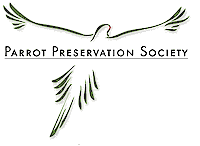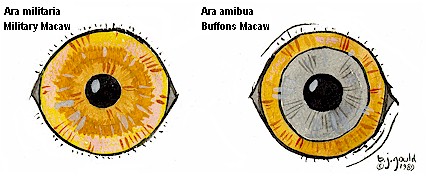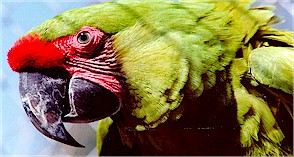 |
| Home |
| Who We Are |
| Save The Parrots |
| Books |
| Links |
| Volunteers |
| Articles |
| Avian Vet Listing |
| Email Us |
Box 13, Point Arena, CA 95468 USA
PH: (213) 819-1723
macaws@parrotpro.com
Buffons Macaws are different. They can be separated visually from the Military Macaw by size, plumage color, and the color of the eye. They are large, certainly
among the largest of the  macaws. Even the subspecies, the Guayaquilensis, is significantly larger than the similar looking Military. The Ambigua averages 2# 12 oz., (19 individuals
weights), males being 6 ounces heavier on average than the females. The Guayaquilensis averages 2# 4 oz., (4 individuals weights), males being 3 ounces heavier on average than
the females. Militaries average 1#15 oz., (22 individuals weights), with no consistent difference between them. These are statistical averages, and by no means a maximum or
a minimum for any individual bird.
macaws. Even the subspecies, the Guayaquilensis, is significantly larger than the similar looking Military. The Ambigua averages 2# 12 oz., (19 individuals
weights), males being 6 ounces heavier on average than the females. The Guayaquilensis averages 2# 4 oz., (4 individuals weights), males being 3 ounces heavier on average than
the females. Militaries average 1#15 oz., (22 individuals weights), with no consistent difference between them. These are statistical averages, and by no means a maximum or
a minimum for any individual bird.
Buffons are a different shade of green than the Military, being more chartreuse than a dark green. I have also seen signature feathers (small out of place colored feathers )on Buffons, sometimes red, yellow or orange, on a bend of the wing or the head. I have yet to see signature feathers on a Military. Photographs of these birds can confuse you; different films, lighting, and developing techniques show all sorts of different shades of color. I have one snapshot of a Buffons that shows a more yellow tone--but it is just ink! People who know birds are really excited about that until I tell them it is really a green bird, and not a yellow mutation.
The Buffons tail feathers are longer, reflecting the overall greater size of the bird, and varying shades of red and orange. Most tail feathers have the vibrant burnt orange, but can shade to a burnt ember color, depending again on the individual bird. The Military's tail tends to keep to the darker, red umber coloring, and a much smaller size.
There is a difference in the eye color which Barbara and I discovered some years ago. The correct eye color is not currently reflected in the hard cover "dictionaries" of parrots. In the Buffon macaw., there is the black pupil, surrounded by a wide, plain steel grey ring, then a fine black line, and one soft yellow band around that. In the Military, there is the pupil, and three orbits of yellow color surround that. These color bands are somewhat diffused into each other. Once you have seen it in person, you will not mistake it. The Guayaquilensis that we have seen also have the distinct grey ring, like the Ambigua.
During the l960's, I was working in the Darien Gap area of Panama, in Central America. This area of Panama and Northern Columbia was little explored. I was collecting parrots for breeding programs. Even then, the Buffons was a rare occurrence. I only saw three small groups of Ambigua: one in Nicaragua, one in Panama, and one in Columbia. I saw no Guayaquilensis. . A recent article by Dale Thompson and Yvonne Patterson, Visiting Tropical Rain Forests, (Birdtalk 12/94) makes the point that these birds migrate from Costa Rica to Nicaragua, and that few return to Costa Rica.
I spent time in the unpopulated regions of Nicaragua, and found a number of them in the local stewpots. This could explain their not returning to Costa Rica. Only when our government gets out of the business of agricultural reform and politics in Central America will these and other flora and fauna stand a chance. Many of our foreign - aid tax dollars support "grand ideas" to facilitate economies and cheap trade goods in these developing countries. Agrarian reform is one area that we directly contribute to deforestation and habitat loss. Coffee, for example, has been turned from small "shade tree family farms " to large corporate giants with row after row of a type of new coffee plant that can stand in the full sun. This may not make a difference to you unless you realize that the small farms had coffee trees mixed in with perhaps 40 other types of trees - an ecosystem, which supported a variety of wildlife. Our "migratory bird census takers" here first noticed a decline in migratory bird populations, and traced much of it back to the new agricultural methods which prefer production for large scale profits instead of habitat for flora and fauna. (Smithsonian Magazine, l994) I have changed my coffee drinking habits, and now do not buy cheap, mass-produced coffees. I use the more expensive, shade grown beans. If you have a choice, please do the same.
There are some dedicated breeders in this country whose early efforts are now producing babies: Joanne Abramson of Raintree Macaws in Ft. Bragg, Cal., Larry and Pam Hanson, Queen Creek Propagators in Queen Creek, AZ., Avicultural Breeding and Research Center in Florida, as well as ourselves. You can acquire these gentle giants from these and other sources for your breeding program.
Buffons can turn up where you least expect them. Our first one, Sergeant Pepper, was advertised in the local paper. His owner, and Air Force Sergeant, brought him home to Arizona from Panama after spending literally months preparing the necessary paperwork for import. Since he was a military persons pet, he qualified to be imported even after the deadline of l976. I still keep all the documents - all 1/2 inch of them! Of course, his owner forgot to tell me, upon our first meeting, that he had not handled the bird in years. Barbara got the full crunch on her arm, a 30-day bruise and a deep flat spot that remains to this day. That is her worst bite. I know the owner thought I would sue him, but I explained it was our fault for offering a strange bird an arm, and wanted his bird anyway. Sarge bit my foot right through my boot so hard that it was also bruised for a month. It is difficult to extract them from your body when you don't want to hurt them. He also would lay on the floor and roll over left or right, responding only to hand signals from my daughter. Then he would see me and fly across the room and try to kill me. Sergeant Pepper still curses his former owner, Richard, and my neighbor is also a Richard-- I have had to explain that the expletives he hears over the fence are not directed at him! This bird has come full circle now, and is a fine parent.
His mate, Bonita, came in as part of a pair from New Mexico. The male is a Bolivian Military, a very rare bird. Both birds were re-mated correctly. When Bonita started laying eggs (immediately after her arrival) she was in unfamiliar surroundings, and kept dropping them from just wherever she happened to be at the time. She was experienced in New Mexico, having been in the same place for years. She had raised a number of hybrid macaws successfully…. Bolivian Military to Buffon crosses). It took me 3 years to get her to lay her eggs in the nestbarrel. She would still kick at them and break some. I added some bantam chickens to our menagerie, and would substitute the more abundant chicken eggs for her own eggs. This worked great, as I could hand incubate her eggs, and give them back to her just in time for hatching. Except, of course, for the one time I miscounted by a day- the look in her eyes was priceless as this little chick ran all over the nest barrel. It simply would not let her feed it or brood it! Since then she has refined her nesting process, and needs no further trickery from me. If you do substitute a dummy egg for a macaw egg, it had better contain a living embryo, and be the right size. They can tell the difference between clay, glass, or store-bought production eggs!
Charlie came from a breeder/importer in Texas who had kept him out of a shipment of Militaries and Buffons, back in l976. She hand raised him, and kept him as a pet. He was sold to me when he was about 12 years old, and has hated me ever since. He does like his mate; she is equally temperamental. Charlie is fine unless I try to get in his enclosure (8x8x16 foot chain link), and I better keep a good eye on him or he will sneak up on me and bite my back or the top of my head.
Sebastian came via a pet store in Minneapolis, purchased from them by a bird fancier that knew that he was not a Military, but was unsure if he was a Buffons. His favorite
phrase is "come here, cuddle up" - and he still likes a little loving. He arrived in the dead of  winter, leaving Minneapolis when it was well below zero, and it was about 75
degrees here. He shipped by Delta Dash, an expensive service but you can ship at any temperature without restrictions, like you get in common airfreight. It is a counter to
counter service. He was very happy to get out of the box and have a shower! He was a real greaseball, it was just too cold back there to shower. He is making babies this year,
after being mated with a domestic hen, Caroline. She was bred by Bill Bennett, in Virginia. Caroline started laying at 5 years of age, dropping an egg on the floor (from 8 feet
up), jumping on one, and literally taking one from the barrel and throwing it out nest entrance. At age 6, she laid three eggs; two she broke, and the third was removed from
the nest and hand raised from the moment she laid it. We will wait and see how she does next year. Maybe we will use the bantam chicken egg trick and at least teach her what
she is supposed to be doing. We would have done that last season, but could not get to the eggs in time.
winter, leaving Minneapolis when it was well below zero, and it was about 75
degrees here. He shipped by Delta Dash, an expensive service but you can ship at any temperature without restrictions, like you get in common airfreight. It is a counter to
counter service. He was very happy to get out of the box and have a shower! He was a real greaseball, it was just too cold back there to shower. He is making babies this year,
after being mated with a domestic hen, Caroline. She was bred by Bill Bennett, in Virginia. Caroline started laying at 5 years of age, dropping an egg on the floor (from 8 feet
up), jumping on one, and literally taking one from the barrel and throwing it out nest entrance. At age 6, she laid three eggs; two she broke, and the third was removed from
the nest and hand raised from the moment she laid it. We will wait and see how she does next year. Maybe we will use the bantam chicken egg trick and at least teach her what
she is supposed to be doing. We would have done that last season, but could not get to the eggs in time.
When we published the eye color difference discovery a few years ago, we were contacted by several people who needed clarification of species for birds that they had. Several were militaries, one or two were Ambigua, and some Guayaquilensis turned up. I collected the Guayaquilensis, and added them to the breeding stock. The Ambiguous were not for sale at that time.
If you are fortunate enough to have one, you know that they do not behave like all other macaws. They have a curious head movement that reminds me of an Egyptian hieroglyphic dance movement in fast forward - a chin thrust that I have not observed in many other macaws. They are very curious, and seem to know just when to laugh at you, generally after being really naughty. The babies, unlike the adult imports, are a joy. They seem to understand their large size, and are gentle giants. All that we have raised remain tame, even though they are in the large outdoor cages now.
Over the years we have had guests from Central and South America who come specifically to see how we are set up to breed macaws. The status is such now that they are needed back in Central and South America for breeding. I would encourage you to get single birds paired up. There are not enough of these magnificent creatures left. Possibly someday, we can return some to protected National Conservation Areas in the Americas.